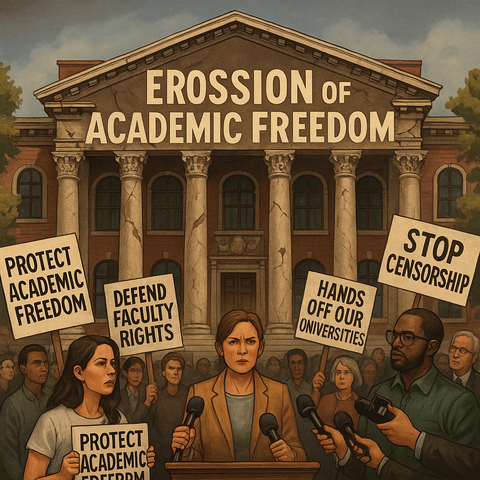“Even Conglomerate-Linked Careers and SKY Degrees Prove Futile” Korea Sinks Into the ‘Medical School Black Hole,’ Derailing Advanced Talent Development
Input
Modified
Talent outflow amid ‘medical school craze,’ even math prodigies diverted to medicine Student exodus from majors with ‘conglomerate job guarantee’ under medical school tilt Hollowing-out of science and engineering talent, mounting concern over weakened national competitiveness

The phenomenon of “all roads leading to medical school” is intensifying. While talent across the United States and other parts of the world pursue billion-dollar ventures through entrepreneurship, Korean students are fixated on the prospect of becoming physicians with million-dollar annual salaries. Among advanced economies, few, if any, are experiencing such a medical school frenzy. Since the 2022 academic year, the top 20 entrance exam majors nationwide have been exclusively medical schools, with even those ranked from valedictorians down to 3,000th place overwhelmingly opting for medicine. Despite the pressing need to secure scientific and technological talent for survival in the global race for technological supremacy, the intensifying tilt toward medical schools is amplifying fears of eroding national competitiveness.
SKY Dropouts Hit Record High as Medical School Quotas Expand
According to University Alimi, the official higher education disclosure platform, the number of dropouts at Korea’s SKY universities (Seoul National, Korea, and Yonsei) reached 2,481 last year, an all-time high. This marks a 2.8-fold increase from the 889 students recorded in 2007, when dropout data was first disclosed. Dropouts include students who withdrew, failed to register, did not return after leave, or were dismissed and never came back.
By discipline, natural sciences recorded the highest dropout number at 1,494, followed by humanities at 917 and arts and sports at 70. At the departmental level, Seoul National’s nursing department posted the highest attrition with 27, while Yonsei’s engineering programs saw 155 and Korea University’s electrical and electronic engineering department had 65. In humanities, Seoul National humanities reported 18, Yonsei humanities 68, and Korea business administration 71.
The record dropout level is widely attributed to the government’s decision last year to abruptly expand medical school admissions for the 2025 academic year. Given the competitive entrance scores and the crossover of liberal arts students into science, it is estimated that a substantial number of these students re-enrolled in medical, dental, or pharmaceutical schools through partial retakes.
Experts warn that the drift of top-performing students from traditional science and engineering to medical fields is set to intensify. Analysis of academic transcripts for the 2025 admissions cycle showed that all six departments requiring a perfect GPA of 1.0 for admission were in medical-related fields, with no representation from general science or engineering. These six departments admitted a combined 79 students, effectively meaning that every student with a flawless transcript enrolled in medical programs.
Extending the cutoff to GPA 1.1 raised the tally to 22 departments with 312 students. Of these, 297 (95.2%) were medical-related, while only 15 (4.8%) were general majors. Breaking it down, medical schools accounted for 267 (85.6%), followed by pharmacy schools with 23 (7.4%) and dentistry with 7 (2.2%). While medical school quotas are scheduled for partial reduction in the 2026 academic year, student preference for medicine and related fields is expected to remain dominant.

Medical Schools Preferred Over Conglomerate-Guaranteed Careers
The surge in medical school preference is especially pronounced in Seoul’s key school districts and autonomous private high schools, where the traditional aptitude-based divide between liberal arts and science has shifted to a performance-based divide, reinforcing the equation “top student equals science track.” Thanks to Korea’s strong culture of educational zeal, the pipeline of potential science and engineering talent at the primary and secondary levels remains robust. Yet with nearly all of these students aspiring to medical school, science and engineering programs are left hollowed out.
Even “employment-linked programs,” created through partnerships between top universities and major conglomerates to guarantee jobs, have proven powerless against the medical school pull. According to Jongro Academy, the semiconductor departments at five major universities—Yonsei, Korea, Sungkyunkwan, Sogang, and Hanyang—recorded an average withdrawal rate of 179.2% for the 2024 admissions cycle. With a combined intake of 79 students, nearly double—138 admitted students—abandoned their offers in favor of other universities.
By company, SK Hynix’s program admitted 30 but saw 60 additional accepted candidates decline, yielding a 200% withdrawal rate. At Hanyang University’s semiconductor engineering, also tied to SK Hynix, 36 students forfeited offers against a quota of 10—a 360% withdrawal rate. Samsung Electronics’ program admitted 47 but lost 78 enrollees. At Yonsei’s system semiconductor engineering department, 65 students abandoned their offers against a quota of 25, a 260% withdrawal rate. Korea University’s semiconductor engineering program saw all 10 admitted students decline. The attrition is explained by overlapping admissions to medical and related fields.
Graduate Programs Underenrolled, Obsession With Predictable Success
The fixation on medical school is not without reason. Stable status, guaranteed high income, and the professional prestige of healing lives make the career universally attractive. In an era when conglomerates no longer guarantee lifetime employment, medicine is perceived as a “stable job without retirement.” But the costs are steep. Graduate schools face talent shortages, and cutting-edge industries such as semiconductors, artificial intelligence, and aerospace—crucial for the nation’s future—are starved of talent. Declining enrollment in science majors and rising dropout rates in general admission at SKY universities highlight the contraction of diverse academic fields.
The collapse of science and engineering under the medical school surge is hitting research directly. According to the Ministry of Education’s “Seoul National University 2025 Graduate Recruitment Fill Rate Report,” 75% of the science and engineering graduate departments failed to fill their quotas. The natural sciences missed 81.6% of quotas, while engineering missed 70.4%. In 40% of cases, applicants fell short of the quota itself. While the government promotes its “10 Seoul National Universities” initiative, even leading science and engineering faculties in Seoul struggle to meet admissions.
Research personnel continue to decline, with Korean science and engineering talent abroad reluctant to return. The Ministry of Science and ICT estimates that 144,000 Korean professionals are working in the U.S. The International Institute for Management Development (IMD) brain drain index ranked Korea 24th among 64 countries in 2021, falling to 30th in 2024. The lower the ranking, the more severe the brain drain.
Compounding matters, Korea’s top talent is overwhelmingly concentrating in so-called “dermatology, ophthalmology, and plastic surgery,” leaving essential and regional medical services on the brink of collapse and stifling medical advancement itself. This hollowing-out erodes national competitiveness. The sudden rise of China’s AI startup DeepSeek earlier this year—shocking the world—was the result of a decade-long, state-backed campaign of massive university investment and the Made in China 2025 initiative. Chinese engineers, trained abroad, returned not out of patriotism but due to government-backed opportunities. The contrast is stark with Korea, where the few students who still choose engineering ultimately depart overseas, rarely to return.





















